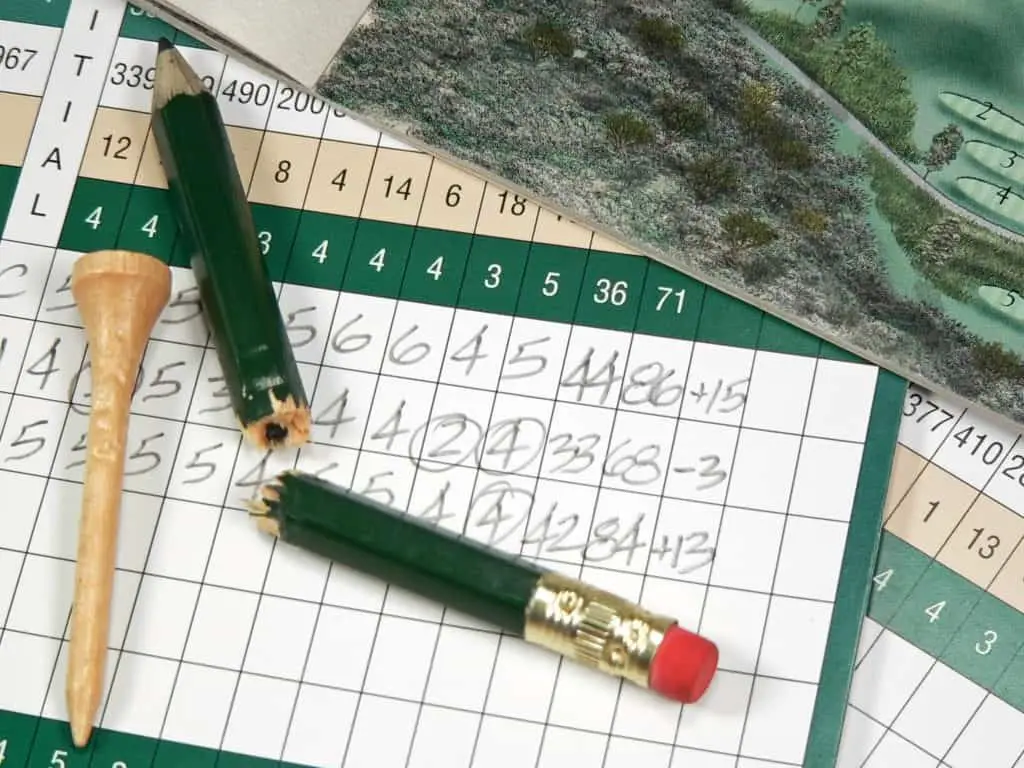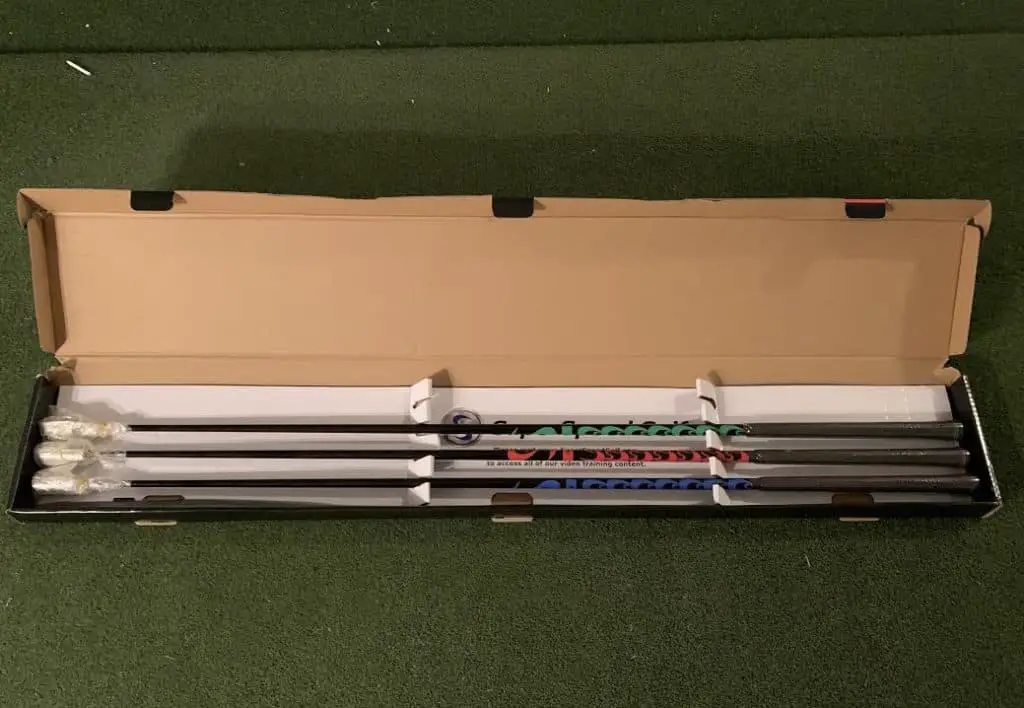7 Areas for Game Improvement:
- Ball Striking
- Developing A Stock Shot
- Training For Speed
- Chipping and Pitching
- Putting
- Mental Game
- Course Strategy
Looking to finally break through your next barrier in golf?
Whether you are trying to break 100, 90, 80 or even 70 for the first time, the golf improvement plan below is a 7 step process you can follow to assess your game and then take action.
In each section below, I identify how to assess where you are at, how to improve in that area and where you need to get to in order to break through that next barrier.
LIke any improvement plan, you need a clear idea of where you currently are, that is why it is important to start with an assessment. We must know where you are at and what level you need to get to.
Golf doesn’t have to be a game where you are struck at the same old scores year in and year out or maybe you have even regressed over the years. These 7 areas should be assess and then take action one day at a time to get better.
In the end, your scores should improve, you will have more fun and hopefully you enjoy the journey along the way. Here at golfjourney365, we look to play golf as often as possible, enjoy the outdoors and shoot our best scores yet.
Let’s admit it, there is nothing better than when you break that next scoring barrier! Are you ready to get started?
Update: All 7 of these areas are so important. The fastest way to game improvement is gaining 20-30 yards off the tee to leave your shorter approach shots, which on average will leave your shorter putts. Which means more made putts. The formula is simple and one can actually gain swing speed nowadays. Speed is not a static part of the today’s golf game. See #3 below! I went from a 6-8 handicap level golfer to scratch in 3 years!

Game Improvement Plan: 7 Areas To Focus On
We believe in the 3 fundamentals of golf laid out by the Stack and Tilt Instructors. These include the following:
- Low Point Control: The golfer must be able to control the low point of his or her swing. The best golfers do this 100% of the time. The weakest golfers might struggle to do this 50% of the time.
- Start Line and Curve of the Golf Ball: The golfer should be able to start the ball on the intended line and ensure the ball doesn’t over curve. The best golfers can do this at least 7 out of 10 times, the weakest golfers might only do this 1 out of 10 times.
- Speed: The golfer must have enough speed to create the distance necessary to play the golf course. The best golfers have plenty of speed and shorten a course, the weakest golfers often struggle to have enough speed to hit the appropriate approach shots into the greens.
You will notice that the first 3 areas of the golf improvement plan are connected to these three fundamentals. Areas 4 and 5 are about short game and 6 and 7 care connected to controlling your mindset and making quality decisions.
#1 Game Improvement Plan: Ball Striking
Fundamentals #1 tells us that the best golfers can control the low point. This directly impacts the ability of the golfer to strike the ball solidly. If the golfer cannot strike the ball solid, he or she will struggle with fundamentals 2 and 3 and never be able to accurately and precisely hit golf shots, especially on approach shots.
Assessment
- Draw a 2-3 foot long yard paint line in your yard.
- With a wiffle ball sitting on the line, see how many times you can have your divot start on the target side of the line.
- Out of 20 attempts, how many times were you successful?
Where you Need To Be
| Break 70 | Break 80 | Break 90 | Break 100 | |
| Out of 20 times | 20 | 18 | 15 | 10 |
These are ballpark numbers of how many times out of 20 you need to be able to do this successfully to get through your next barrier? Where are you currently at and where do you need to get to? If you are weak in any of the 7 areas or strong in the other 7, these numbers may vary based on your overall strengths and weaknesses.
What To Do Next
If your numbers are less than where you need them to be at. Taking 20 consecutive swings without stopping and see if you can continue to control the low point. Several tips to help you with your low point control.
- Your weight needs to get back to your front foot if you shift off of it on the backswing.
- Keep your center more centered and try loading 60% on the front foot and maintaining that throughout the swing.
- Visualize the club entering just on the front side of the ball.
- Focus on the target out front and swing towards the target, not at the golf ball.
Resource: Why do I hit fat golf shots (3 solutions)

#2 Game Improvement Plan: Developing A Stock Shot
Fundamental #2 tells us that the golfer must be able to control the start line and curve of the ball. The best golfers in the world can do this a high percentage of the time. This results in being able to eliminate one side of the golf course. Have you ever stood over a ball and had no idea where it was going to end up?
This is a bad feeling! If you develop a stock shot (a draw or fade) you can play with confidence on the start line of the ball and then ensuring that it doesn’t over draw.
Assessment
- At the driving range, take an alignment stick and place it on your target line about 6 yards in front of you.
- Take a second alignment stick and place it 2-3 feet right of the first alignment stick.
- Try to hit shots through these two sticks to start to develop a push draw as your stock shot. If you want to develop a stock fade, place the 2nd stick on the left side of the first stick.
- Go ahead and measure how many times out of 10 you can do this successfully!
Where You Need To Be
| Break 70 | Break 80 | Break 90 | Break 100 | |
| Out of 10 times | 7 | 5 | 3 | 1 |
What To Do Next
The Stock Shot assessment can continue to be your drill. Use this drill as frequently as your practice. Hit at least 10-20 balls each time while trying to get it through the gate. You can spend an entire range session simply working on your start line. Once you can get the low point control in place and start hitting balls down your target line, you are on pace to break through your next barrier.
Having the confidence as you stand over a shot in which direction the ball will fly, you will increase your success and start to feel like you are playing golf instead of hitting and praying!
Resource: What is a stock shot in golf? (how to develop)
#3 Game Improvement Plan: Training For Speed
As much as you may have heard the old saying, “drive for show, putt for dough” the reality is that having enough distance with your driver and your irons is important. The analytics tell us the following:
The further you can drive the ball, the shorter approach shot you have into the green. The shorter the approach shot, the closer you will hit the ball in proximity to the pin on average. Tge closer you are to the pin, the higher the make percentage is with your putt.
For example, if you driver the ball 260 yards and are left with a 130 yard shot instead of 170, you will hit the ball closer on average. The more 15 foot putts you have vs 40 foot putts increases your chance to make more putts. Speed and distance matter in golf! You can’t be hitting 175 yard approach shots into greens all day and expect to play to your highest level!
Assessment
Find a way to measure your swing speed. I would recommend this handy speed radar if you already don’t have something. It is good to monitor your swing speed over time.
Where You Need To Be
Here is a speed chart to compare your swing speed to:
| Below 100 | Below 90 | Below 80 | Below 70 | |
| Driver Swing Speed | 91 and Below | 91-101 | 102-112 | 113-123 |
| Driver Distance | 210 and Below | 210-235 | 235-275 | 275-300 |
| 3 Wood Distance | 200 | 220 | 230 | 243 |
| Hybrid Distance | 190 | 205 | 215 | 225 |
| 4 iron Distance | 170 | 185 | 195 | 203 |
| 5 iron Distance | 160 | 175 | 185 | 194 |
| 6 iron Distance | 150 | 163 | 173 | 183 |
| 7 iron Distance | 140 | 153 | 163 | 172 |
| 8 iron Distance | 130 | 143 | 153 | 160 |
| 9 iron Distance | 120 | 131 | 141 | 148 |
| pw Distance | 110 | 121 | 131 | 136 |
| sw Distance | 90 | 100 | 110 | 120 |
| lw Distance | 70 | 80 | 90 | 105 |
Once again, if you have a really strong short game or have a strength in one of the other areas, you can still shoot better scores. Or if you play from shorter tee boxes. However, overall if you took the driver swing speed of a golfer, there is a direct correlation to their golf handicap on average. The higher the swing speed, the lower the handicap.
What To Do Next
All golfers should consider training for speed. With the great options on the market today, there aren’t many reasons someone can’t gain 5-8% in their swing speed. I would highly recommend using the SuperSpeed Golf Training System to increase your swing speed initially and then to have it become more permanent over time.
I have been able to gain 7-10 miles per hour in my swing speed from these training protocols. The SuperSpeed System works and it only takes 15 minutes every other day. If you are serious about adding speed, invest the money in the SuperSpeed System and get to work. My goal is to reach 113 miles per hour and am currently at 107 on average. Over time, I can get there and so can you!
Check out the current price of SuperSpeed golf, here!
Potential results with SuperSpeed System:
| Original Swing Speed | After 4-6 Weeks | New Carry Distance | Total Distance |
| 95 | 102 | 245 | 265 |
| 100 | 108 | 259 | 279 |
| 105 | 113 | 271 | 291 |
| 110 | 118 | 283 | 303 |

#4 Game Improvement Plan: Chipping and Pitching
Did you know that the average scratch golfer is able to scramble for par 54% of the time? Being able to save par when you miss a green might be the fastest way to break through your next barrier. The pros can oftentimes reach 75-80% on weeks when they are scoring their best.
Assessment
Over the next 5 rounds you play, track how many times you are able to save par when you miss a green. Write these numbers or down or track in a spreadsheet to get a good idea of where you are at. For the current season, I am at 50% and want to get my number closer to 60%.
Resource: What club to use for chipping
Where You Need To Be
| Break 70 | Break 80 | Break 90 | Break 100 | |
| Scrambling Percentage | 54% | 44% | 34% | 24% |
Once again, these numbers could fluctuate depending on your strengths and weaknesses in other areas, but are ballpark numbers you can use to measure where you are at and where you might want to get to.
What To Do Next
Put the following drill into place:
- At a practice green, after hitting some warm up chips, take one golf ball and play this game.
- Randomly throw your ball into different places around the practice green.
- Pick a hole and hit your chip or pitch shot.
- See if you can then make the putt.
- Out of 20 times, how many times can you do this successfully?
- Write this down and track over time.
I have found that my numbers when playing this game are slightly better than when I am on the golf course because I can get into a routine and build the feel. So whatever your number might be, you can expect a slight drop when compared to your scrambling percentage on the course.
This game is great to play because the pressure builds up and you have to be able to make the putt. You combine your chip and pitch shots with some putting practice, while adding some pressure of trying to produce a certain success percentage.
Resource: The basics of chipping!

#5 Game Improvement Plan: Putting
DId you know that the maker percentage on the PGA Tour is only 50% from 8 feet? This speaks volumes to the importance of speed training and have shorter shots to leave shorter putts for your birdie or par putts. It also shows that to be a great scrambler, you have to chip the ball close.
With that being said, we must get better at two different sets of putts. The putts 10 feet and closer and the putts outside of 30 feet. We must be able to lag the ball inside of 3 feet from 30 plus feet and we must be able to make some putts inside of 10 feet.
Assessment
Over your next 5 rounds, track how many times you 3 putt from 30 feet or more and how many putts inside of 0-5 feet your make and 6-10 feet. Keep these percentages over time.
Where You Need Te Be
You can compare your puttin certanges to the pros and strive to get to their level. Putting doesn’t take speed, power or great athletic ability. Just some desire to practice and the ability to start the ball on your intended line at the right speed.
| Distance | Less than 3′ | 4′ | 5′ | 6′ | 7′ | 8′ |
| Odds of One Putting on PGA Tour | 99.40% | 92% | 80.80% | 70.30% | 60.90% | 51.80% |
*Data was compiled by GolfTec
What To Do Next
Practice your putting as frequently as possible, focusing on your putts inside of 10 feet and your lag putts out of 30 feet. There are two keys to putting, controlling your start line and controlling your speed. Over time, you can trust your process of reading greens and seek that further if it becomes an issue.
Resource: 22 Golf Practice Games
#6 Game Improvement Plan: Mental Game
There are many different books out there on how to control your mindset and your emotions on the golf course. Being fully committed to a shot with low tension seems to be a theme. This leads us to the assessment.
Assessment
In your next 5 rounds, attempt to fully commit to each shot, have a clear plan and track how many times out of your round you were fully committed with the right mindset.
Where You Need To Be
It is difficult to measure where you need to be, but the more you can be committed to a shot, with a clear plan, the better chances you have of playing your best golf. When you don’t commit to a shot and just hit the ball, your chances for success decrease greatly. Find a way to commit and measure your level of commitment to each shot.
What To Do Next
I would highly recommend two books to help you create your system for the mental side of the game. These books are of high quality and worth the read:
#7 Game Improvement Plan: Course Management
Many golfers waste many shots on a golf course. They select the wrong club, make the wrong play and end up adding shots all over the place. The higher the handicap, the more likely you aren’t playing the right shot to match your swing and your current ability level.
The most simple advice I received as a young junior golfer was to try to be around the green in regulation. From there, have a strong short game and save par 40% of the time. This means if I missed every green in regulation for 9 holes, I would still shoot in the low 40s. Many golfers would take scores for 9 holes in the low 40s.
I have created complete guides on breaking through your next barrier from a course management perspective. They are worth checking out.
Final Thoughts: Game Improvement Plan
Golf is a wonderful game. A journey to get better is fun to go on. Be warned that progress in the game of golf doesn’t not happen in a straight line progressing upwards. These line will have ups and downs in it. The score doesn’t always reflect your current ability overal ability level.
Use the assessments above, to monitor your ball striking, start lines, speed numbers and short game numbers to see where you are really at. Eventually, it will transfer to your score, but there will be good days and bad days.
IF you are really serious about game improvement I would also recommend adding a portable launch monitor to your golf collection. The ability to get the following feedback is rather helpful:
- Ball Speed
- Spin Rate
- Spin Axis
- Launch Angle
- Carry Distance
Being able to practice and knowing these vital numbers can increase your rate of improvement and help you bust through that next barrier.
